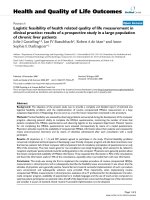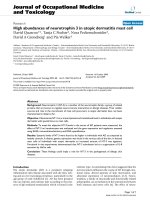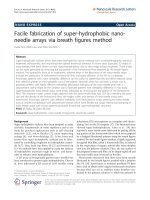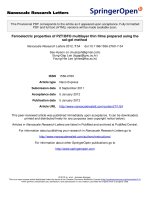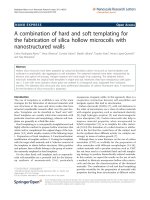Báo cáo hóa học: " Lithography-Free Fabrication of Large Area Subwavelength Antireflection Structures Using" pdf
Bạn đang xem bản rút gọn của tài liệu. Xem và tải ngay bản đầy đủ của tài liệu tại đây (390.86 KB, 7 trang )
NANO EXPRESS
Lithography-Free Fabrication of Large Area Subwavelength
Antireflection Structures Using Thermally Dewetted Pt/Pd Alloy
Etch Mask
Youngjae Lee Æ Kisik Koh Æ Hyungjoo Na Æ
Kwanoh Kim Æ Jeong-Jin Kang Æ Jongbaeg Kim
Received: 26 November 2008 / Accepted: 8 January 2009 / Published online: 24 January 2009
Ó to the authors 2009
Abstract We have demonstrated lithography-free, sim-
ple, and large area fabrication method for subwavelength
antireflection structures (SAS) to achieve low reflectance
of silicon (Si) surface. Thin film of Pt/Pd alloy on a Si
substrate is melted and agglomerated into hemispheric
nanodots by thermal dewetting process, and the array of the
nanodots is used as etch mask for reactive ion etching
(RIE) to form SAS on the Si surface. Two critical param-
eters, the temperature of thermal dewetting processes and
the duration of RIE, have been experimentally studied to
achieve very low reflectance from SAS. All the SAS have
well-tapered shapes that the refractive index may be
changed continuously and monotonously in the direction of
incident light. In the wavelength range from 350 to
1800 nm, the measured reflectance of the fabricated SAS
averages out to 5%. Especially in the wavelength range
from 550 to 650 nm, which falls within visible light, the
measured reflectance is under 0.01%.
Keywords Subwavelength antireflection structure Á
Nanostructure Á Thermal dewetting Á Self-agglomeration
Introduction
Solar energy is considered as one of the most important
alternative energy sources and solar cell has been actively
studied as promising solar energy conversion device. For
its practical use, however, there are numbers of technical
barriers to be overcome such as high cost and low-con-
version efficiency. Accordingly, numerous researches have
been performed on organic solar cells for low-cost manu-
facturing [1] and antireflection surface of the solar cells to
improve the energy absorption efficiency [2–14].
The formation of antireflection surfaces reduces the
reflection of incident light and increases its transmission
into solar cells. Antireflection surfaces have been usually
fabricated by coating thin films. A thin film layer on the
surface can diminish the reflection of the incident light by
the destructive interference between the reflected lights
from the top and bottom surfaces of the coated layer
when the film thickness is about a quarter wavelength of
incident light [3]. To induce this effect for a range of
different wavelengths, multiple layers of thin films are
coated typically. However, inevitable thermal mismatch
between each thin film layer often causes adhesion and
stability problems in the thin film type antireflection
surfaces [2]. To avoid these stability problems, antire-
flective nano structures with a period smaller than the
wavelength of light are fabricated from a single material.
Reflection occurs when the light propagate through the
interface of two materials of different refractive indices
due to their discontinuous change [3, 4]. At the interface
of the nano-structured material and the air, an effective
refractive index at any cross-section orthogonal to the
direction of incident light is determined by the areal
fraction of the structural material and the air [5], and the
tapered SAS can make the continuous and monotonous
change of the effective refractive index from air to solid
surface [3, 4, 6]. Therefore, the array of tapered nano
structures reduces the reflection of incoming light for a
wide range of wavelengths [3–6].
Y. Lee Á K. Koh Á H. Na Á K. Kim Á J. Kim (&)
School of Mechanical Engineering, Yonsei University,
134 Shinchon-dong, Seodaemun-Gu, Seoul 120-749, Korea
e-mail: ;
J J. Kang
Korea Institute of Industrial Technology (KITECH), Bucheon-si,
Kyunggi-do, Korea
123
Nanoscale Res Lett (2009) 4:364–370
DOI 10.1007/s11671-009-9255-4
The fabrication of SAS requires subwavelength scale
etch mask patterns. Previous works to make the etch mask
relied on costly and complicated nano patterning tech-
niques such as e-beam [2, 7] and nanoimprint lithography
(NIL) [8]. Simpler methods to generate etch mask patterns
in subwavelength scale on a large area were developed
recently, including thermal dewetting of Ni film on SiO
2
surfaces [9] or on GaN layers [10], Ag deposition on heated
substrates [11], and dispersion of nanospheres [12–14].
Thermal dewetting of the Ni film resulted in non-tapered
and irregular-shaped SAS array, where the refractive
indices cannot be changed monotonously giving relatively
high reflectance. Both approaches of Ag deposition and
dispersion of nanospheres resulted in low aspect ratio
structures. Consequently, they showed relatively inferior
antireflectance compared with tapered SAS fabricated by e-
beam lithography. Besides, the necessity of additional SiO
2
etch masks in the method using dewetted Ni etch masks
increases the number of fabrication steps, and therefore,
reduces the cost-effectiveness. In this paper, Pt/Pd alloy
thin films are thermally dewetted, and thus, hemispherical
shape Pt/Pd nanodot arrays are formed. Using these
nanodot arrays as dry etch masks, capacitively coupled
plasma-reactive ion etching (CCP-RIE) using Cl
2
and N
2
gases is then performed to form tapered SAS arrays with
narrower width at the top and wider at the bottom. Our
tapered SAS fabricated by the simplest method reported so
far using agglomerated Pt/Pd nanodots maintain as low
reflectance as NIL-based approaches achieved.
Fabrication
Schematic diagram of fabrication process and scanning
electron microscope (SEM) images for each step of
tapered SAS formation are shown in Fig. 1. Pt/Pd alloy
thin film of 10 nm thickness is deposited on (100) Si
substrate by sputtering. The samples are then heated at
1,073 K for 90 s in rapid thermal annealing system to
induce thermal dewetting of deposited Pt/Pd film.
Fig. 1 Fabrication process flow
for tapered subwavelength
antireflection structures: a Pt/Pd
alloy thin film deposition with a
thickness of 10 nm; b thermally
dewetted Pt/Pd alloy nanodot
etch mask formed at an elevated
temperature; and c formation of
tapered subwavelength
antireflection structures after
RIE
Nanoscale Res Lett (2009) 4:364–370 365
123
Thermal dewetting occurs due to the increased surface
energy of the metal film by heating. When the surface
energy of the Pt/Pd thin film is bigger than the sum of the
surface energy of Si substrate and the interfacial energy
between two layers, the film begins agglomerating to be
minimum energy state with uniform contact angle [15].
Figure 2 shows the SEM and atomic force microscope
(AFM) images of the thermally dewetted Pt/Pd film of
10 nm thickness. In the AFM image, the scanned area is
10 lmby10lm. Agglomeration proceeds as the heating
time increases, as shown in Fig. 2a–c, since the longer
heating time enhances the surface energy of thin film. As
a result, the Pt/Pd thin film is completely agglomerated
into hemispherical nanodot array with subwavelength
period Fig. 2c, d.
The array of hemispherical nanodots is then used as an
etch mask for CCP-RIE using Cl
2
and N
2
gases at the flow
rate of 50 sccm for each and the RF power of 300 W.
During the RIE process, the etch mask nanodots are also
etched slowly, while the silicon is etched much faster.
Moreover, since the nanodots are in hemispherical shape,
the edges of nanodots are consumed faster in the RIE,
exposing silicon under the nanodots. The size of nanodots
becomes smaller as the RIE is proceeded, and the RIE time
difference between the unmasked silicon and the silicon
exposed later due to the nanodot etching makes the angled
sidewall of SAS as shown in Fig. 1c.
Figure 3 shows SEM images of thermally dewetted Pt/
Pd nanodots generated from three different film thick-
nesses. Figure 3b is magnified to fit the scale with other
images. In Fig. 3a, c, and d, the Pt/Pd thin film is com-
pletely dewetted, but in Fig. 3b, the Pt/Pd thin film is not
completely dewetted due to the insufficient thermal energy.
As the thickness of Pt/Pd alloy thin film is increased, more
thermal energy is needed for complete agglomeration and
bigger Pt/Pd nanodots are formed. Thick Pt/Pd thin film
leads to increased distance between nanodots and
decreased number of nanodots in the same area. To achieve
small reflectance, the period of antireflection structure
should be less than the wavelength divided by the refrac-
tive index of substrate [16]. Considering that and from the
repeated fabrication results, we decided to use 10 nm
thickness Pt/Pd film for further etching process.
Figure 4a–d are the SEM images showing different
height and shape of SAS for different etching time. As the
etching time of RIE is increased from 60 to 110 s, the
average height of tapered SAS is also increased from 230
to 470 nm. These samples are used to find the optimum
fabrication process that produces the lowest reflectance.
The etch rate of Si substrate in the experiment ranges from
4 to 5 nm/s. When a sample is etched for 110 s, the
nanodot etch masks almost disappear and the average
height of tapered SAS reaches the maximum of 470 nm.
According to the SEM image in Fig. 1b and AFM graph in
Fig. 2 Thermal dewetting
process of Pt/Pd alloy thin film
for different heating time (a–c)
and AFM image of dewetted
nanodots (d)
366 Nanoscale Res Lett (2009) 4:364–370
123
Fig. 2d, the typical height of Pt/Pd nanodots after thermal
dewetting step falls within the range of 80–130 nm.
Therefore, the calculated etching selectivity of Si substrate
to Pt/Pd nanodots in our fabrication is about 4–5:1. In
Fig. 4d after the RIE for 120 s, it is recognized that the
height has been slightly reduced compared to the etching
result for 110 s and the sidewall of tapered SAS is
roughened. The reason for the reduced heights is that the
tips of the structures are etched faster than the bottom of
the structure when the nanodot etch masks are completely
removed.
Results and Discussion
For the repeated tests to find optimized recipe for thermal
dewetting and RIE process, the Si wafer is broken into
number of pieces and SAS were processed on them as
shown in Fig. 5. The surface of the Si substrate with fab-
ricated SAS array in Fig. 5a seems black due to the low
reflectance while the bare Si wafer in Fig. 5b reflects the
image of the camera that took this picture due to the high
reflectance. However, considering the fabrication process is
composed of only metal thin film deposition, heating and
RIE without costly and time-consuming nano patterning
steps such as electron beam lithography or nanoimprint
lithography, the tapered SAS fabrication could be easily
extended to wafer scale larger area. In Fig. 6, the SEM
image of the angled view of the tapered SAS array fabri-
cated in the large area is shown.
Since the tapered sidewall and height of SAS decide
antireflective property, not only the formation of nanodot
arrays by thermal dewetting but also the control of etching
process is critical. RIE etching characteristics strongly
depend on plasma density. As ion density and its energy
differ between CCP-RIE and ICP (inductively coupled
plasma)-RIE, they result in different etching rate and
selectivity [17]. Since RIE with chlorinated plasma does
not have large loading effect compared to CF
4
plasmas, the
chemical reaction during the silicon RIE in Cl
2
plasma is
not as much as in CF
4
plasma [18]. Less chemical attack
means the etching is relatively more physical, giving less
chance of undercut. This is important for tapered SAS
formation, and therefore, Cl
2
plasma-based CCP-RIE is
adopted in our fabrication. As shown in Figs. 4 and 6, the
diameter of the tapered SAS continuously increases from
top to bottom and thus the refractive index also continu-
ously increases. Consequently, it is expected that the
reflectance is very small for a wide range of wavelengths of
light.
To assure the aforementioned, the reflectance of the
fabricated SAS was measured by UV-VIS-NIR spectro-
photometer (Varian Cary 500). Figure 7 shows the
reflectance measured as a function of the wavelengths of
Fig. 3 Thermal dewetting of
Pt/Pd alloy thin film for
different thickness
Nanoscale Res Lett (2009) 4:364–370 367
123
the light irradiated on five different sets of tapered SAS
array with different heights generated by different etching
time. The reflectance of bare silicon wafer is also presented
for comparison. In the wavelength range from 350 to
1,800 nm, all of the differently processed samples show
average reflectance under 5.5%. On the other hand, the
measured average reflectance of bare Si wafers in the same
wavelength range is 35%. In infrared range (700–
1800 nm), the 420 nm height SAS array shows the smallest
average reflectance value of 3.17%. In visible wave range
(400–700 nm), the smallest reflectance is achieved on the
SAS array with the heights of 370 nm and the average
reflectance is 1.12%. Moreover, this sample shows extre-
mely low reflectance value under 0.01% in a specific
visible range of 570–650 nm. All samples show the smaller
reflectance in visible wave range than in infrared or ultra
violet wave range. This result is meaningful especially for
solar cell applications since 46% of solar energy is in the
visible wave range. In theory, the reflectance of the struc-
ture is expected to be decreased as the height of the
Fig. 6 An SEM image (60° angle) of a high aspect ratio, large area
subwavelength antireflection structures array
Fig. 5 Si substrate (a) with fabricated SAS array is compared to bare
Si substrate (b). Due to the low reflectance of the SAS array, substrate
(a) seems completely black, while the highly reflective bare Si
substrate (b) reflects the image of the camera that took this picture
Fig. 4 Side view of
subwavelength antireflection
structure array for different
etching time. The measured
average heights of SAS are: a
230 nm, b 370 nm, c 470 nm,
and d 450 nm
368 Nanoscale Res Lett (2009) 4:364–370
123
structures increases. However, the measured average
reflectance in the whole wavelength range from 350 to
1,800 nm decreases only to the height of 420 nm where the
average reflectance is 2.80% and higher reflectance is
observed for 450 and 470 nm structures. The measured
average reflectance in visible and infrared range also shows
the similar result. As a possible reason for this, it is pre-
sumed that the measured reflectance value could be slightly
different depending on the specific location on the substrate
due to the nonuniformity of the fabrication process. As
described earlier, the reflectance is decided not only by the
height of the SAS, but also by the period and taper angle.
Since our SAS array is formed on a large area, it is possible
that each fabrication step contains nonuniformity such as
different Pt/Pd film thickness between center and edge of
the substrate, which will lead to different sizes and periods
of nanodot etch masks on the identical substrate.
Nonuniform RIE may also result in the variation of the
taper angle of SAS array between different locations of the
substrate. Considering the further application of the SAS
array as nano mold that could be replicated to polymers for
low-cost antireflective surface formation, our monoto-
nously tapered SAS is also advantageous, since previous
works adopting thermal dewetting and etching produced
mushroom-like shape of nanopillars with which demolding
process is difficult.
Conclusions
In this paper, we presented simple and large area fabrica-
tion methods for tapered SAS without expensive and
complicated nano patterning processes. By using the ther-
mally dewetted Pt/Pd nanodots as etch mask and
performing CCP-RIE with Cl
2
and N
2
gases, tapered SAS
array was fabricated on large area silicon substrate. The
monotonously tapered shape of fabricated SAS gives
continuous and smooth increase of refractive index along
the incident light path, resulting in very low reflectance
\5.5% for 350–1,800 nm range of wavelength. Especially
for visible light range, the measured reflectance of 1.12% is
as low as the SAS fabricated by e-beam or nanoimprint
lithography. The proposed method is expected to be
applied not only to solar cell but also to optical and opto-
electronic devices such as display screens and light sensors.
Acknowledgment This research was supported by Nano R&D
program through the Korea Science and Engineering Foundation
funded by the Ministry of Science & Technology (2008-02916), and
partially by a Grant-in-Aid for New and Renewable Energy Tech-
nology Development Programs from the Korea Ministry of
Knowledge Economy (No. 2008-N-PV08-P-06-0-000).
References
1. J.Y. Kim, K. Lee, N.E. Coates, D. Moses, T Q. Nguyen, M.
Dante, A.J. Heeger, Science 317, 222 (2007). doi:10.1126/
science.1141711
2. Y. Kanamori, M. Sasaki, K. Hane, Opt. Lett. 24, 1422 (1999).
doi:10.1364/OL.24.001422
3. Y. Kanamori, E. Roy, Y. Chen, Microelectron. Eng. 78, 287
(2005). doi:10.1016/j.mee.2004.12.039
4. H. Kobayashi, N. Moronuki, A. Kaneko, Int. J. Precis. Eng.
Manuf. 9, 25 (2008)
5. A. Gombert, W. Glaubitt, K. Rose, J. Dreibholz, B. Blasi, A.
Heinzel, D. Sporn, W. Doll, V. Wittwer, Sol. Energy 68, 357
(2000). doi:10.1016/S0038-092X(00)00022-0
6. E.B. Grann, M.G. Moharam, D.A. Pommet, J. Opt. Soc. Am. A
12, 333 (1995). doi:10.1364/JOSAA.12.000333
7. H. Toyota, K. Takahara, M. Okano, T. Yotsuya, H. Kikuta, Jpn J.
Appl. Phys. 40, 747 (2001). doi:10.1143/JJAP.40.L747
8. Z. Yu, H. Gao, W. Wu, H. Ge, S.Y. Chou, J. Vac. Sci. Technol. B
21, 2874 (2003). doi:10.1116/1.1619958
Fig. 7 The reflectance measured as a function of the wavelengths of
light irradiated on subwavelength antireflection structures with
different height
Nanoscale Res Lett (2009) 4:364–370 369
123
9. G R. Lin, Y C. Chang, E S. Liu, H C. Kuo, H S. Lin, Appl.
Phys. Lett. 90, 181923 (2007). doi:10.1063/1.2736281
10. C.H. Chiu, Y. Peichen, H.C. Kuo, C.C. Chen, T.C. Lu, S.C.
Wang, S.H. Hsu, Y.J. Cheng, Y.J. Chang, Opt. Express 16, 8748
(2008). doi:10.1364/OE.16.008748
11. S. Wang, X.Z. Yu, H.T. Fan, Appl. Phys. Lett. 91, 061105 (2007).
doi:10.1063/1.2767990
12. T. Nakanishi, T. Hiraoka, A. Fujimoto, S. Saito, K. Asakawa,
Microelectron. Eng. 83, 1503 (2006). doi:10.1016/j.mee.2006.
01.193
13. C H. Sun, P. Jiang, B. Jiang, Appl. Phys. Lett. 92, 061112
(2008). doi:10.1063/1.2870080
14. Xu H, Lu N, Qi D, Hao J, Gao L, Zhang B, Chi L (2008) Small.
doi:10.1002/smll.200800282
15. J M. Lee, B I. Kim, Mater. Sci. Eng. A 449–451, 769 (2007).
doi:10.1016/j.msea.2006.02.403
16. W.H. Southwell, J. Opt. Soc. Am. A 8, 549 (1991). doi:
10.1364/JOSAA.8.000549
17. Y. Hikosaka, M. Nakamura, H. Sugai, Jpn J. Appl. Phys. 33, 2157
(1994). doi:10.1143/JJAP.33.2157
18. G.C. Schwartz, P.M. Schaible, J. Vac. Sci. Technol. 16, 410
(1979). doi:10.1116/1.569962
370 Nanoscale Res Lett (2009) 4:364–370
123
